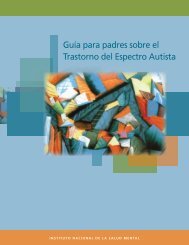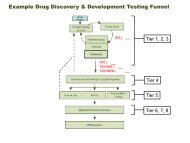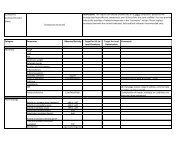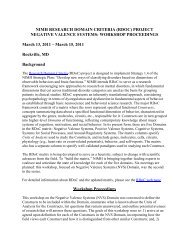Brain's Inner Workings: Teacher's Manual - NIMH
Brain's Inner Workings: Teacher's Manual - NIMH
Brain's Inner Workings: Teacher's Manual - NIMH
Create successful ePaper yourself
Turn your PDF publications into a flip-book with our unique Google optimized e-Paper software.
Modern Neuroscience Education<br />
Most biology courses begin by asking students to define “life”—a task that challenges even the most<br />
experienced researchers. Students often offer descriptions of structures they’ve seen (“cells”) or<br />
physiological processes (“breathing”) that reflect their limited experience with the diversity of the<br />
living world.<br />
Yet the most essential elements of living things are often the hardest for beginning life science students to<br />
conceptualize. At the most basic level, the list includes:<br />
• Living things use energy to maintain their organization and structure;<br />
• Living things can replicate themselves;<br />
• Living things can evolve; and<br />
• Living things respond to their environment to preserve balance (homeostasis).<br />
The fourth characteristic, response (or more technically, irritability), is crucial. It is intuitive once students<br />
begin to consider their own observations of the natural world. Yet it is the one that is covered least thoroughly<br />
in most secondary programs. The framers of the National Science Education Standards clearly defined<br />
behavior as one of the most important goals of secondary life science:<br />
CONTENT STANDARD C: As a result of their activities in grades 9-12,<br />
all students should develop understanding of:<br />
• The cell<br />
• Molecular basis of heredity<br />
• Biological evolution<br />
• Interdependence of organisms<br />
• Matter, energy, and organization in living systems<br />
• Behavior of organisms<br />
THE BEHAVIOR OF ORGANISMS<br />
• Multicellular animals have nervous systems that generate behavior. Nervous systems are formed from<br />
specialized cells that conduct signals rapidly through the long cell extensions that make up nerves.<br />
The nerve cells communicate with each other by secreting specific excitatory and inhibitory molecules.<br />
In sense organs, specialized cells detect light, sound, and specific chemicals and enable animals to<br />
monitor what is going on in the world around them.<br />
• Organisms have behavioral responses to internal changes and to external stimuli. Responses to external<br />
stimuli can result from interactions with the organism’s own species and others, as well as environmental<br />
changes; these responses either can be innate or learned. The broad patterns of behavior exhibited<br />
by animals have evolved to ensure reproductive success. Animals often live in unpredictable environments,<br />
and so their behavior must be flexible enough to deal with uncertainty and change. Plants also<br />
respond to stimuli.<br />
• Like other aspects of an organism’s biology, behaviors have evolved through natural selection.<br />
Behaviors often have an adaptive logic when viewed in terms of evolutionary principles.<br />
• Behavioral biology has implications for humans, as it provides links to psychology, sociology,<br />
and anthropology.<br />
http://www.nap.edu/readingroom/books/nses/6e.html#ls<br />
2 The Brain’s <strong>Inner</strong> <strong>Workings</strong>: A Guide for Teachers<br />
Na t i o n a l Institute of Me n t a l He a l t h

















